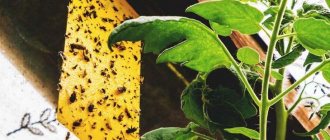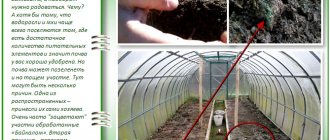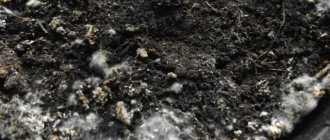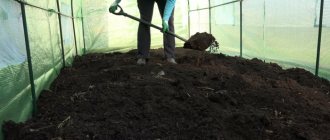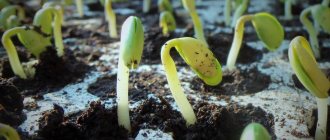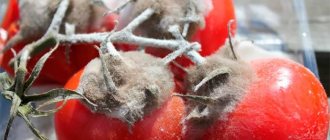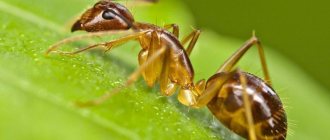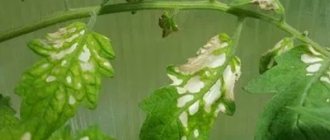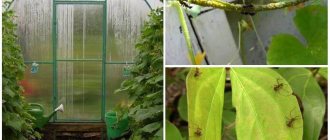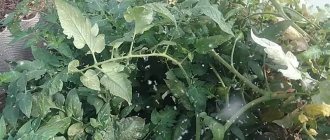General information about mold on seedlings
Mold is a lower plant organism that can live in soil, air, water, etc. It can spread in the form of individual microscopic branched threads of mycelium and spores.
When parts of the mycelium and spores find themselves in a favorable habitat, they begin intensive reproduction in the surface layers of the soil, in which the underdeveloped root system of seedlings is located. It is not resistant to the developing parts of the mycelium, which penetrates its vascular system.
After some time, the roots of the maturing plant begin to secrete a special substance that suppresses the proliferation of mycelium. Due to this, it loses its inhibitory property. However, if mold appears on the ground with seedlings, the gardener must promptly take appropriate measures to combat it. Otherwise, there is a possibility that the young plant will die before it has time to grow.
Why is mold dangerous for seedlings?
White plaque on the soil, as well as on seedlings of any plant (tomatoes, cucumbers, peppers, etc.) can cause its rotting and death. Under certain conditions, a fungal infection can begin to actively reproduce in the soil. Mold is an external expression of this problem that requires more detailed study.
Having noticed that the ground with seedlings is covered with white mold, the gardener must immediately take appropriate measures, because young plants do not have the same resistance to fungal infections as adults.
Experts have concluded that the ideal circumstances for the occurrence of this problem are temperature levels varying between 20-22 °C, as well as excessive air humidity. In addition, mold can be caused by insufficient ventilation in the room where the seedlings are located.
Video
What do I do if mold appears on the soil in seedlings?
Mold on Seedlings - What to Do and How to Get Rid of Mold. The soil in Rassada is growing moldy.
MOLD ON SEEDLINGS: saving plantings quickly and easily!
IF MOLD APPEARED IN A TRAY WITH SEEDLINGS... Olga Chernova.
Mold on seedlings. Let's solve the problem. Mold on the soil with seedlings.
Mold on the ground in seedlings - what to do?
Mold on seedlings! - how to get rid of it?
Has mold appeared on the seedlings? I'll tell you how quickly I get rid of it."
✔⚡? SAVING SEEDLINGS! ?WHAT TO DO IF MOLD APPEARS ON THE GROUND?✔LOBELIA SPROOTS!
Mold on seedlings will disappear!!
Mold on the ground near the seedlings
Mold appeared on the seedlings. What to do
WHAT TO DO IF MOLD APPEARS ON THE SEEDLINGS?
White plaque on the ground with seedlings, find out the reason for its appearance
Mold on the ground, what am I doing!
Mold and efflorescence in seedlings. Gardeners' experience.
Mold on the surface of the soil! How to deal with it!
MOLD ON THE GROUND WITH SEEDLINGS.WHAT ARE THE REASONS AND ERRORS IN CARE.WHAT TO DO.STEP-BY-STEP INSTRUCTIONS.
How do you like the article?
Ivanova Tatyana
Ask a Question
Why does the soil in seedlings become covered with white mold?
The ideal conditions for the appearance of white plaque on the ground in seedlings are:
- incorrectly selected or prepared soil (heavy in structure, non-moisture-holding, causing stagnation of liquid);
- increased level of humidity in the air (95% or more) and in the prepared substrate (80% or more);
- too high air temperature (19°C or more);
- lack of ventilation in the room where the seedlings are located;
- insufficient amount of light and ultraviolet radiation, which is blocked by window glass into the room;
- inappropriate size of container in which the young plant grows;
- improper soil moisture regime;
- seedlings are watered with “hard” liquid;
- insufficient drainage at the bottom of the container;
- dry air.
How to remove mold from the soil on seedlings
The best option for preserving the integrity and maintaining the health of young sprouts is to initially prevent the appearance of white plaque on seedlings of tomatoes, cucumbers or other plants. But if this does happen, there are several ways to combat this problem.
Soil replacement
Most often, if the soil is covered with mold in seedlings, experienced gardeners replace the contaminated part of the soil with new, healthy soil. However, some people carry out this procedure many times and do not achieve any significant results due to the fact that the soil begins to become covered again with microscopic fungi in even larger quantities.
Attention! Replacement of soil can only be carried out if the seedlings already have a well-developed root system and this measure cannot harm it.
Folk and chemical remedies
The advantages of folk remedies, as opposed to chemical ones, are that they are safer for a young plant, and also more accessible.
The most common folk remedy that can be useful when seedlings are covered with a white coating is ordinary baking soda. To combat mold, you need to dilute 0.5 teaspoon of sodium bicarbonate in one liter of water and spray young plants with the resulting liquid.
You can also spray the seedlings with an ash solution. To prepare it, you need to take two teaspoons of ash and dilute it in a liter of boiling water. The solution must infuse. In the absence of ash, you can use charcoal or activated carbon.
Despite the advantages of folk remedies, they are not always able to cope with the problem. In this case, the gardener must resort to the use of chemicals that are designed to combat mold.
After germination, mold on the soil and seedlings can be treated with oxychome, cichome, quadris, basezol or cuproxate. These substances are classified as fungicides. They are developed specifically to combat fungal infections.
The fungicide must be dissolved in water. The resulting liquid is intended for spraying a container with seedlings. In addition, this solution can be used as a prophylactic agent by adding it to the soil 2-3 days before planting the seeds. Typically, each drug is sold along with instructions for use and dosage.
You can treat mold on seedlings with biological products such as phytosporin, gamair-SP, alirin-B, etc. However, these products are less effective compared to chemical ones.
How to remove mold from the ground on seedlings by mulching
If the soil in the seedlings becomes moldy, it should be mulched. This event is also a good preventive measure to prevent the occurrence of fungal diseases. During the mulching process, a mixture of charcoal and wood ash (1:2) should be used.
Using river sand
Also, if the seedlings are covered with a white coating, you can pour river sand onto the contaminated soil and fluff it thoroughly.
Apical rot and streak
Blossom blossom occurs when there is a lack of calcium in the soil. If the leaves turn white unevenly or take on an unnatural shade, then it is possible that your seedlings have been attacked by blossom end rot. Without receiving enough mineral, seedlings begin to wither. If the situation is not corrected in time, you can lose the entire crop sown on this soil. If the correct conditions for growing tomatoes are observed, this disease will not attack your plantings.
Streak disease can affect entire tomato seedlings. With this disease, tomatoes begin to become covered with streaks of brown and white. The stem becomes thin and very brittle. Streak has no cure and will be nearly impossible to track early on. First, the seedlings grow, they develop ovaries, and then fruits, which grow to the level of peas and then fall off. Only after this, the leaves begin to change color. To avoid such a disease, it is best to buy factory-processed seeds.
Why do peat pots with seedlings become moldy?
If the peat pots containing the soil with seedlings are covered with a white coating, this means that their bottom part is in constant moisture. In nature, mold spores spread very quickly, they can even be in the air. And the constant wet surface of the container in tandem with high temperature and poor ventilation becomes an ideal environment for the appearance of microscopic fungi.
If the seedlings are not grown in a residential building, then you can resort to treating the surface of the container with vinegar or a household chemical designed to combat mold. Afterwards you should reduce the number of waterings. Ideally, you should stop watering the sprouts and start spraying them with a spray bottle, moistening the soil only in those places where the roots are located.
In addition, to combat fungal diseases, you can use ash by dusting the surface of peat pots with it.
Treatment with solutions
Soak the soil with prepared solutions of antifungal agents, trying not to get it on the leaves of the plants. The soil around small seedlings can be carefully moistened with a medical syringe. In containers with large seedlings, the soil can be sprayed with a spray bottle. To treat seedlings against mold and fungi, use the following solutions:
- 1% solution of potassium permanganate,
- Fitosporin solution prepared according to instructions,
- solution of Nystatin tablets (1 tablet per 250 ml of water),
- solution of Metronidazole tablets (1 tablet per 1 liter of water, water only the soil),
- a solution of 3% hydrogen peroxide (2 tablespoons are diluted in 1 liter of water, the solution is sprayed on the seedlings and the soil is watered with it).
Mold prevention
To prevent mold from appearing on seedlings of cucumbers, tomatoes or other plants, it is necessary to provide them with favorable conditions for growth. To do this, the seeds and soil should be treated before planting. After these preventive measures, the likelihood of contracting fungal infections will be zero.
You can treat the soil in the following ways:
- Fold a large piece of gauze material twice so that it is laid in 4 layers. Place soil in the center. Tie the opposite corners of the fabric to make a bag. Keep it in a double boiler for 50-60 minutes.
- Pour a small amount of water into a metal bucket with a volume of 10 liters and place it on low heat. Place a taganka at its bottom, and place a 5 liter bucket on it with holes in the bottom. This bucket should be filled with soil. This procedure must be carried out within an hour.
- Set the oven temperature to 110°C. Sprinkle soil on a baking sheet and place it in the oven for half an hour.
The treated soil can be used for planting seeds after 14-16 days, during which its microbiological properties will be restored. To prevent the soil from becoming susceptible to fungal diseases, it must be stored in sterile containers.
Seeds can be processed using the following methods:
- Pour boiling water over the planting material. This procedure must be carried out very quickly. It will require very little boiling water.
- Soak the planting material in a manganese solution. The temperature should be within 40°C. The procedure must be carried out for about a quarter of an hour.
High temperature and excess moisture
Very often, under the influence of direct sunlight and high temperatures, tomato leaves begin to curl. In this way, tomatoes try to protect themselves from moisture loss. In the evening, the leaves bloom again to replenish their moisture reserves. To protect the plants, a canopy is built over them during sunny hours. In such a situation, many summer residents usually make the grave mistake of starting to water the tomatoes in the midst of the heat. This is not recommended, especially if you water by rain. With this method of watering, the water remaining on the leaves works in the sun like a magnifying glass, gradually burning out the foliage.
An excess of moisture, as well as a deficiency, can harm plantings and this can manifest itself in white stains on seedlings. This usually happens during a rainy period of summer. During heavy rains, if the soil is clayey, then water begins to accumulate near the rhizomes, cutting off the access of oxygen to them. Without receiving air, the plant begins to wither and dry out over time. To prevent this situation, when planting tomatoes, add loose soil to the soil so that water is absorbed faster. It serves as a kind of drainage system. In the bed itself, small furrows are made from the stem to the side for unimpeded drainage of water.
